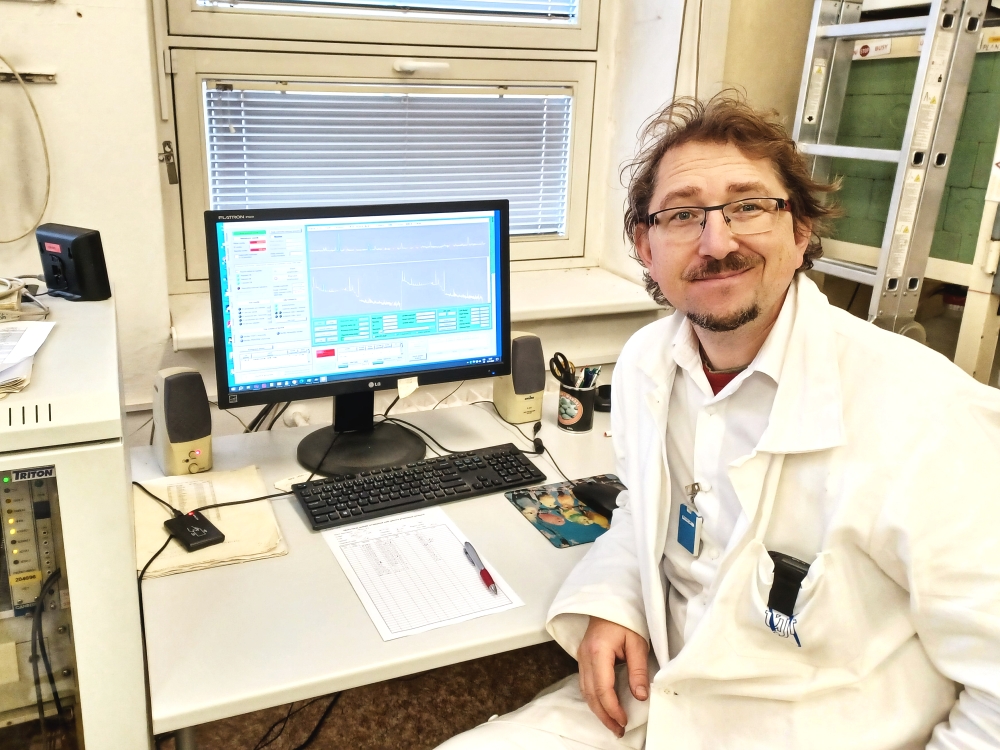
Neutron activation analysis at NPI helped to discover new species of endangered fungi
14. 11. 2024

At least eleven distinct species have been identified within what was previously classified as the spring fungus Sarcosphaera coronaria. The discovery was made by researchers from the Nuclear Physics Institute, the Institute of Geology, and the Institute of Microbiology of the Czech Academy of Sciences, in cooperation with other research institutions and amateur mycologists from the Czech Republic and the USA. Their findings, which include the description of two entirely new species, was made possible by measuring the arsenic content using neutron activation analysis. The breakthrough study on the rare fungus was published in Mycological Progress.
The conspicuously colorful Sarcosphaera coronaria, commonly known as the pink crown, the violet crown-cup, or the violet star cup, is a rare spring fungus classified as endangered and appears on red lists of threatened species in several European countries, including the Czech Republic. Knowledge about this species is essential for conservation efforts. Historically considered edible, it has caused several cases of severe poisoning, leading to a current recommendation against consumption despite no toxic compounds having been definitively identified in the fungus. S. coronaria is known to accumulate arsenic at levels up to 1,000 times higher than typically found in mushrooms, although earlier research involving Czech scientists revealed that the arsenic it contains is primarily in the form of methylarsonic acid, which is significantly less toxic than inorganic arsenic.
Though primarily a European species, S. coronaria also grows in North America and has even been found in North Africa. Using an unusual analytical method, neutron activation analysis, scientists at the Nuclear Physics Institute of the CAS examined arsenic levels in several American specimens and found them to be significantly lower than those in European samples. This discovery prompted the team to conduct DNA analysis on a large number of Sarcosphaera specimens obtained from museum collections and, crucially, from amateur mycologists in both the Czech Republic and the United States.
“It turned out there are far more species within the Sarcosphaera genus than previously thought. This was a huge surprise, as these distinctive fungi have been studied for over two hundred years. However, the newly identified species are extremely similar to each other, with only minor differences. In Europe, we have identified two species – S. coronaria and S. crassa – neither of which occur in North America, where we’ve found at least seven additional species, two of which we described as new in our study,” explains Jan Borovička from the Nuclear Physics Institute and the Institute of Geology of the CAS.
The crucial involvement of amateur mycologists
A key component of the study was obtaining dozens of samples of this relatively rare fungus, which became possible thanks to the involvement of mushroom aficionados. “Obtaining samples from North America was critical, and this was made possible by the growing enthusiasm for mycology in the United States, where an active community of mushroom foragers exists. These enthusiasts were invited to participate in the process of describing the new species, some of which now bear their names. Several additional species remain undescribed until more samples are collected, which we hope will be possible in the near future,” Borovička adds.
To study the global distribution of Sarcosphaera, researchers also used data from Globalfungi.com, a database developed by scientists at the Institute of Microbiology of the CAS. Unlike traditional methods of acquiring fungi distribution data, which rely on collecting the fruiting bodies of mushrooms, this database includes information gathered directly from environmental samples by means of sequencing all fungal genetic material present. This enables scientists to detect the presence of fungi without the need to directly observe them at specific locations. In the case of Sarcosphaera, the data showed that the fungus is fairly abundant in certain areas and that European species have different ecological requirements. While both European species grow exclusively on calcareous soils, S. coronaria forms symbiotic relationships with fir, spruce, and beech trees, whereas S. crassa primarily associates with pine trees.
The discovery of multiple Sarcosphaera species in Europe may also help clarify previous cases of poisoning linked to this fungus. It was once thought that the toxin gyromitrin, known from the closely related Gyromitra esculenta, might be responsible. However, renowned Swiss chemist Tjakko Stijve found no gyromitrin in his analysis of S. coronaria in the 1970s – however, he examined only one sample, representing just a single species. It is therefore possible that only one of the two European species is toxic, similar to how some Gyromitra species are edible while others are poisonous.
The research also showed that arsenic accumulation occurs in multiple Sarcosphaera species, raising questions about the factors behind this accumulation and the biological role of storing such a toxic element. The new study not only aids conservationists in their efforts, but also provides a foundation for further taxonomic research, especially in the United States.
Read also
- NPI involved in research on advanced battery technologies
- Dr. Andrej Kugler Presented the Current Status of the FAIR-CZ Project
- We Joined the First Annual Radioactive Day
- Milan Štefánik is the new head of the Department of Accelerators
- Within the framework of EU projects, the NPI offers the use of instrument time on its facilities
- NPI to organise ReMade workshop in Prague in May 2025
- The Scientific Advisory Board of the FAIR-CZ project met for the tenth time
- Iva Synková from DNIM received the Martina Roeselová Memorial Fellowship
- Prof. Ondřej Lebeda gave a lecture at FEE CTU
- We were at the launch of NuPECC's Long Range Plan

